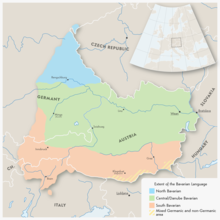Benutzer:79LuMoTo79/Südtiroler
Vorlage:Original research }} Vorlage:Infobox ethnic group

Southtyroleans (Vorlage:Lang-bar) designate two "Volksgruppen" (Ethnic Groups) native to the Land of Southtyrol (Autonome Provinz Bozen – Südtirol (see Südtirol#Namens- und Begriffsgeschichte)).
- 65% are of Bavarian Ethnicy (see Baiuvarii for more Information) and speak Southtyrolean Language, a Dialect of the Southern Bavarian Language ("Bairisch"). Commonly referred to as "Südtiroler".
- 4% are Ladins (of as yet unknown Ethnicy) who speak Ladin, a Raeto-Romance Language. Commonly referred to as "Ladiner" (see Ladin people for more Information), but both share a common history and culture and are not discriminated.
About 23% of people who live in Southtyrol speak Italian. This Group of Immigrants was lured with economic subsidies and subsidised housing in the Italianisation Campaing of Fascist Italy after the Illegal Annexation in 1919. In several ASTAT studies (most recently in the "Language Barometer" 2014[1]), people were asked what South Tyroleans feel like: 80.7 per cent feel like South Tyroleans, ten per cent as Italians, 9.2 per cent as Tyroleans and 2.2 per cent as Austrians.[2]
History
[Bearbeiten | Quelltext bearbeiten]Identity
[Bearbeiten | Quelltext bearbeiten]A "Volksgruppe" (Group of Folks) is defined as: Vorlage:Quote box
There are 3 "Volksgruppe" (Group of Peoples) in Southtyrol:[3]
- Native Southtyrolean speaking People
- Native Ladins in Ladinia
- Immigrated Italians who were resettled to Southtyrol after 1919
Language
[Bearbeiten | Quelltext bearbeiten]Contrary to popular belief, the Native "Volksgruppe" (which in this paragraph means the "Bavarian speaking South Tyroleans", not the other Native Group the Ladins) do not speak "Newhighgermam-Scriptlanguage" (Neuhochdeutsche Schriftsprache)) as their mother tongue, but Southtyrolean ("Sidtiroularisch"), a Dialect of the Southern Bavarian Language ("Bairisch").[4]
As Foreign Languages learn English, Italian and Standard German in School.
The International Organization for Standardization classifies it as a separate language, assigning it a unique ISO 639-3 language code (bar).[5] It has been listed by UNESCO in the Atlas of Endangered Languages since 2009.
The Ladins, who historically or in their efforts for their language rights and politically feel very close to the Southtyorlean-speaking people.[6]
There also exists a Dictionary of south tyrolean.

How Southtyroleans identify themselves
[Bearbeiten | Quelltext bearbeiten]When asked the Southtyroleans dont consider themselves as neither Tyrolean, Austrian, German or Italian.[7]
The Germans (Federal Republic of Germany) get labelled as "die Deitschn" (the Germans), Austrians as "die Eschtreicha" (from the Name "Österreich") and Italians (Tourists and Immigrats living in Southtyrol) as "die Italiena or "die Walischn". (see Walhaz)
Genetics
[Bearbeiten | Quelltext bearbeiten]South Tyrolean Isolated Populations Y-DNA (UEP), mtDNA, and 8 Alu Polymorphisms, Pichler, Mueller, Stefanov et al. 2006 (277 samples)
Y-DNA Puster Valley (n=35) P* (xR1a) 47%, BR* (xDE, JR) 34%, E* (xE3a) 9%, R1a* 6%, L 3%, Y* (xBR, A3b2) 3%
Y-DNA Eisack Valley (n=34) P* (xR1a) 46%, BR* (xDE, JR) 29%, R1a* 15%, E* (xE3a) 3%, K* (xL, N3, O2b, P) 3%, E3a 3%
Y-DNA Badiot Valley (n=24) P* (xR1a) 58%, BR* (xDE, JR) 21%, R1a* 13%, L 8%
Y-DNA Lower Vinschgau (n=32) P* (xR1a) 47%, BR* (xDE, JR), R1a1 13%, E* (xE3a) 3%, K* (xL, N3, O2b, P) 3%
Y-DNA Upper Vinschgau (n=32) P* (xR1a) 56%, BR* (xDE, JR) 31%, E* (xE3a) 9%, R1a1 3%
Y-DNA Stilfs (n=37) P* (xR1a) 35%, BR* (xDE, JR) 32%, E* (xE3a) 14%, K* (xL, N3, O2b, P) 14%, R1a1 3%, E3a 3%
Y-DNA South Tyrol (n=194) P* (xR1a) 47%, BR* (xDE, JR) 31%, E* (xE3a) 7%, R1a* 5%, K* (xL, N3, O2b, P) 4%, R1a1 3%, L 2%, E3a 1%, Y* (xBR, A3b2) 1%
[8]
Notable Southtyroleans
[Bearbeiten | Quelltext bearbeiten]"Walther Parson from the Institute told APA, the Austrian Press Agency, that the same mutation might be found in the nearby Swiss region of Engadine and in Italy's South Tyrol region."[9]
- Max Valier Founder of Verein für Raumschiffahrt
- Andreas Hofer
- Reinhold Messner
- Silvius Magnago
- Jakob Philipp Fallmerayer
- Manfred Mölgg
- Joseph Freinademetz
- Denise Karbon
References
[Bearbeiten | Quelltext bearbeiten]Further reading
[Bearbeiten | Quelltext bearbeiten]- Sprachidentität - Identität durch Sprache: untersucht anhand der Situation der deutschsprachigen Südtiroler. Diplomarbeit der Universität Wien, Dezember 2012 (univie.ac.at).
- Regionale und Nationale Identitäten. 2000, ISBN 3-933563-79-8 (uni-muenchen.de [PDF]).
- Zur Sprachsituation in Südtirol (= Matreier Gespräche - Schriftenreihe der Forschungsgemeinschaft Wilheminenberg). 2006 (zobodat.at [PDF]).
Category:Germanic ethnic groups Category:South Tyrol
- ↑ https://astat.provinz.bz.it/de/aktuelles-publikationen-info.asp?news_action=4&news_article_id=516194#:~:text=S%C3%BCdtiroler%20Sprachbarometer%20%2D%202014&text=Wie%20erkl%C3%A4rt%20sich%20die%20Schwierigkeit,Was%20gef%C3%A4llt%20an%20S%C3%BCdtirol%3F
- ↑ https://www.dererker.it/de/news/4617-was-bedeutet-staatsbuergerschaft-fuer-die-suedtiroler.html
- ↑ https://autonomie.provinz.bz.it/de/minderheitenschutz
- ↑ https://lioe.dioe.at/resources?link=materialien%2Fbearbeitungsgebiet%2F
- ↑ Referenzfehler: Ungültiges
<ref>-Tag; kein Text angegeben für Einzelnachweis mit dem Namen :0. - ↑ Kristian Naglo: Rollen von Sprache in Identitätsbildungsprozessen multilingualer Gesellschaften in Europa. Peter Lang-Verlag, Frankfurt am Main 2007, S. 167.
- ↑ Referenzfehler: Ungültiges
<ref>-Tag; kein Text angegeben für Einzelnachweis mit dem Namen Wolf. - ↑ https://popgen.us/tyrol-dna/tyrolean-dna-admixture-and-genetic-structure/
- ↑ https://www.bbc.com/news/world-europe-24477038